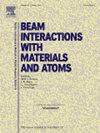On some unsettled half-lives of AMS radionuclides
IF 1.4
3区 物理与天体物理
Q3 INSTRUMENTS & INSTRUMENTATION
Nuclear Instruments & Methods in Physics Research Section B-beam Interactions With Materials and Atoms
Pub Date : 2025-07-16
DOI:10.1016/j.nimb.2025.165802
引用次数: 0
Abstract
Half-lives ought to be accurate, and preferably precise as well. This contribution discusses cases of long-lived radionuclides used in measurements with accelerator mass spectrometry (AMS), where multiple half-life measurements on specific radionuclides do not agree within the stated uncertainties. This we call “unsettled” half-lives. We include also some cases where only very old half-life measurements (>50 years ago) exist, sometimes only one single measurement. Half-life measurements of the following radionuclides are being discussed: 32Si, 53Mn, 59Ni, 79Se, 135Cs, 146Sm, and 209Po. These radionuclides are of interest for a variety of applications with AMS where accurate half-life values would be important.
AMS放射性核素的一些未确定半衰期
半衰期应该是准确的,最好也是精确的。本文讨论了在加速器质谱(AMS)测量中使用的长寿命放射性核素的情况,其中对特定放射性核素的多个半衰期测量在所述不确定度内不一致。我们称之为“不稳定的”半衰期。我们还包括一些只有非常古老的半衰期测量值(50年前)存在的情况,有时只有一次测量值。讨论了下列放射性核素的半衰期测量:32Si、53Mn、59Ni、79Se、135c、146Sm和209Po。这些放射性核素对AMS的各种应用很有兴趣,其中精确的半衰期值很重要。
本文章由计算机程序翻译,如有差异,请以英文原文为准。
求助全文
约1分钟内获得全文
求助全文
来源期刊
CiteScore
2.80
自引率
7.70%
发文量
231
审稿时长
1.9 months
期刊介绍:
Section B of Nuclear Instruments and Methods in Physics Research covers all aspects of the interaction of energetic beams with atoms, molecules and aggregate forms of matter. This includes ion beam analysis and ion beam modification of materials as well as basic data of importance for these studies. Topics of general interest include: atomic collisions in solids, particle channelling, all aspects of collision cascades, the modification of materials by energetic beams, ion implantation, irradiation - induced changes in materials, the physics and chemistry of beam interactions and the analysis of materials by all forms of energetic radiation. Modification by ion, laser and electron beams for the study of electronic materials, metals, ceramics, insulators, polymers and other important and new materials systems are included. Related studies, such as the application of ion beam analysis to biological, archaeological and geological samples as well as applications to solve problems in planetary science are also welcome. Energetic beams of interest include atomic and molecular ions, neutrons, positrons and muons, plasmas directed at surfaces, electron and photon beams, including laser treated surfaces and studies of solids by photon radiation from rotating anodes, synchrotrons, etc. In addition, the interaction between various forms of radiation and radiation-induced deposition processes are relevant.

 求助内容:
求助内容: 应助结果提醒方式:
应助结果提醒方式:


